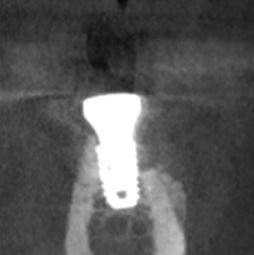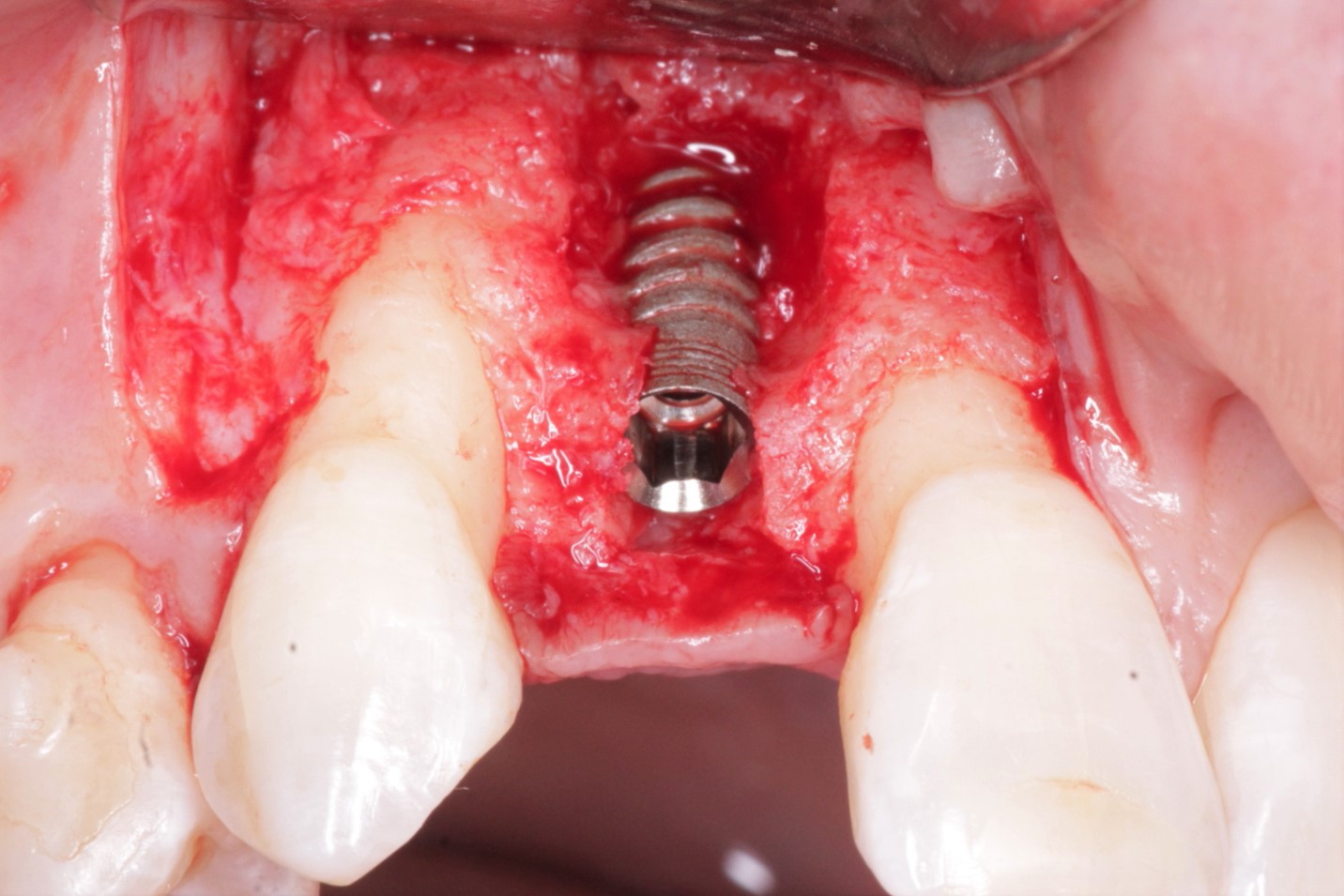Aesthetic Gingival Architecture Techniques
Dr. P. asks:
I recently took a course with Dr. Petrungano from Minnesota. He demonstrated how the best time to form highly aesthetic gingival architecture in the maxillary anterior aesthetic zone is at the time of implant placement. He uses Zimmer implants with very aggressive apical cutting tips and HA coating that enhance primary stability.
At the time of dental implant placement, he makes temporary crowns with apically placed proximal contact areas that maintain the inter-proximal papillae. His approach is to support and mold the gingival architecture so the papillae do not collapse to form black triangles.
Has anybody tried his approach? Any potential complications? Any other aesthetic tips related to this type of situation?
6 Comments on Aesthetic Gingival Architecture Techniques
New comments are currently closed for this post.
Alejandro Berg
3/27/2007
That technique works great, similar to Peter Whorle´s. I have used also the half pontic technique which is nice but has more complications. The idea of using more cervical and longer interprox. contact areas instead of more incisal contact spots is designed to reduce the distance fron the bone to them so it will be easier for the gum to fill it (most patients only gets 3mm of gum height, and less than 20% can get 5 or more).
So use that approach, it works nice
Jeff Ganeles
3/27/2007
Paul Petrungaro is very enthusiastic, but he is also smart. Certainly placing a provisional at the time of implant surgery will preserve the papillary architecture. But you have to be careful about the patients you choose to treat this way as there is almost always some amount of facial crestal bone loss and recession. The more delicate the biotype (thin tissue) or greater the pre-extraction bone loss or inflammation, the more recession you will likely see. Sloppy restorative techniques, ragged margins and subgingival cement can exacerbate these problems even more.
So I would be very careful in applying this technique in patients with thin tissue, high smile lines and significant pre-operative pockets. You can create an uncorrectible esthetic nightmare if you do not do an accurate pre-operative assessment. Dr. Petrungaro and any responsible educator should offer the same caveat.
Ron Neff
3/31/2008
There are two kinds of cases, let's call them immediate and remote.
In an immediate socket placement case make sure to place the implant slightly lingually. This optimizes blood flow to the thin buccal plate and helps sustain soft tissue heights. It is not enough to just let the socket guide the implant placement.
The soft tissue preoperatively must be as healthy and unimflamed as possible. Titanium in grafted sockets will generate bone growth, the final interproximal bone height is unknowable. I've had to cut bone away from the implant healing caps after bone grafting. So placing the contact artificially low (apically) at this point is a mite pessimistic to me.
Leave a narrow embrasure with the contact point at the incisal 1/3 or 1/2 point. Give the embrasure time to breathe during the provisionalization period.
I use an expandable implant that can be tightened in the bone, supports the provisional from day one,
Ron Neff
3/31/2008
There are two kinds of cases, let's call them immediate and remote. Assuming you are speaking of the 'immediate' situation.
I would not place the contacts apically at the provisionalization stage, let the bone and papilla heal with space and place the final restoration with long contacts apically if indicated in the final impression. Have the lab use a tissue masque.
In an immediate socket placement case make sure to place the implant slightly lingually. This optimizes blood flow to the thin buccal plate and helps sustain soft tissue heights. It is not enough to just let the socket guide the implant placement.
The soft tissue preoperatively must be as healthy and unimflamed as possible. Titanium in grafted sockets will generate bone growth, the final interproximal bone height is unknowable. I've had to cut bone away from the implant healing caps after bone grafting. So placing the contact artificially low (apically) at this point is pessimistic to me.
Leave a narrow embrasure with the contact point at the incisal 1/3 or 1/2 point. Give the papilla time to breathe during the provisionalization period.
I use an expandable implant that can be tightened in the bone over the first few weeks and supports the provisional from day one, and can be restored with the final crown at 8 weeks. By then I know where the papillae is likely to finally reside, and the patient is not having to spend six months with black triangles.
In the case of a 'remote' implant careful custom incision making can help to build papilla around the implant in the case where immediate (same day) provisionalization is used.
Let stipulate that the anatomy of an implant is less than natural at the gingival aspect. The temporary has to be crafted to incorporate a plethera of concepts dimensional and biologic, organic and inorganic. Essentially the concavities under the enamel, the convexities at the cervical, the roundness of the implant versus the ovoid or triagular root, t
Ron Neff
3/31/2008
There are two kinds of cases, let's call them immediate and remote. Assuming you are speaking of the 'immediate' situation.
I would not place the contacts apically at the provisionalization stage, let the bone and papilla heal with space and place the final restoration with long contacts apically if indicated in the final impression. Have the lab use a tissue masque.
In an immediate socket placement case make sure to place the implant slightly lingually. This optimizes blood flow to the thin buccal plate and helps sustain soft tissue heights. It is not enough to just let the socket guide the implant placement.
The soft tissue preoperatively must be as healthy and unimflamed as possible. Titanium in grafted sockets will generate bone growth, the final interproximal bone height is unknowable. I've had to cut bone away from the implant healing caps after bone grafting. So placing the contact artificially low (apically) at this point is pessimistic to me.
Leave a narrow embrasure with the contact point at the incisal 1/3 or 1/2 point. Give the papilla time to breathe during the provisionalization period.
I use an expandable implant (Sargon) that can be tightened in the bone over the first few weeks and supports the provisional from day one, and can be restored with the final crown at 8 weeks. By then I know where the papillae is likely to finally reside, and the patient is not having to spend six months with space above the papilla
In the case of a 'remote' implant careful custom incision making can help to build papilla around the implant in the case where immediate (same day) provisionalization is used. These techniques are bey
ond the scope of this message board.
Let stipulate that the anatomy of an implant is less than natural at the gingival aspect. The temporary has to be crafted to incorporate a plethora of concepts dimensional and biologic, organic and inorganic. Essentially the concavities under the enamel, the convexities at the cervical; the roundness of the implant versus the ovoid or triagular root; the inter-root distance vesus the increased implant root allowance, the lack of a saddle at the margin versus an organic crown prep, all of these must be considered and incorporated into the provisional design with that done expertly the soft tissue can be manipulated realitively easily.
CONCEPCION AGUIRRE
6/9/2008
i am waiting for an implant . the doctor who did the extraction asked me to wait a year or longer to allow bone growth to be able to do the implant. he said, after the bone grows i will need surgery to place the implant and i will be very swollen for about 2 weeks. and after it heals i will need to go to another dentist for a crown. please give me feedback about the steps i have to take and the time i have to wait. or do i have another choice with the sargon technique? i live in los angeles and i would like an implant specialist in my area who would be willing to do the implant for me. thanks concepcion aguirre 310 430 1281

















